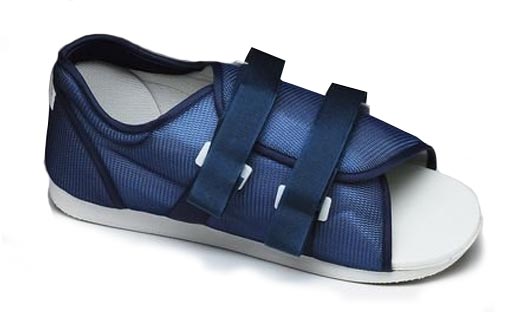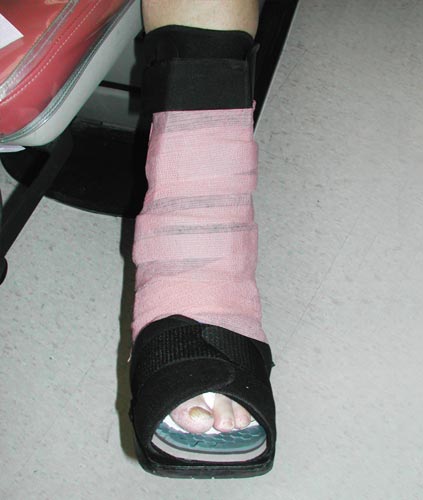|
Offloading – It’s What You Take off that Counts!
Since I’ve been working on offloading projects for the last few months, I thought it would be appropriate to discuss this very important aspect of wound care this month. I know, it’s not glamorous for podiatric surgeons in training, but it is a crucially important component of wound care – before, during, and even after healing diabetic foot ulcers (DFU). Since diabetic foot ulcers are becoming an increasingly frequent pathology in most of our practices, it will serve us well to have a thorough understanding of the importance of offloading in the management of our complicated patients. We recognize that most plantar ulcers result from repetitive or high plantar pressures. Accordingly, such pressures must be addressed and mitigated if healing is to occur. Unfortunately, many lesions occurring on non-plantar surfaces can be attributed to pressure from tight footwear or constricting bandages – we see this all too often in our clinics. While we have many advanced therapeutic agents for wound healing at our disposal, we can never forget the importance of the basics of wound care – and especially the importance of pressure reduction (offloading) in promoting healing of potentially limb threatening lesions. Very simply stated, when a wound is the result of excessive pressure sustained on the foot, we cannot expect that lesion to heal without removing the underlying cause (high pressure). Many plantar wounds are the result of walking on deformities, be they a Charcot midfoot prominence or a prominent metatarsal head. High pressures can also occur when no ostensible deformity is actually present. In such cases, the actual “deformity” might be a gastrocsoleus equinus deformity leading to higher than normal forefoot pressures during walking. Your biomechanical training will prove to be a valuable skill in the evaluation and management of such patients. 
Although “surgical offloading” often becomes necessary in recalcitrant or advanced cases, most patients can initially be treated with fairly straightforward techniques to reduce those high pressures at the source of the plantar foot wounds. Hence, no patient who comes into your clinic wearing a shoe should leave wearing a standard shoe on the ulcerated foot. You simply cannot effectively treat a DFU while allowing your patient to continue wearing the same shoe that might have caused the ulcer. The total contact cast (TCC) has been long considered as the “gold standard” offloading modality for several reasons based on numerous studies. (Figure 1) A TCC ensures adherence to offloading since it cannot be removed- it is actively engaged at every step. Healing rates are higher for the TCC than just about any other modality, partially due to the forced compliance attendant with the cast. Equally important, the cast distributes the pressures over the entire surface of the foot as well as on the leg- thereby mitigating excessively high pressures underlying most plantar foot ulcers. Drawbacks to the TCC are the skills required to effectively (and safely) apply the casts, as well as time and costs associated with such applications each week or two. Hence, casting is not used as frequently as it probably should be.

A wonderful innovation that better controlled patients’ unimpeded ambulation was the development of the irremovable CAM walker – the so called “instant Total Contact Cast” (iTCC). (Figure 3) To address those patients who removed their devices at will, the fixed ankle walkers were rendered irremovable by applying cast tape or plastic binders to them. Of course, industrious patients could always remove these as well with some difficulty, but not as easily as the unmodified devices. In a study comparing these two modalities, Healing rates were found to be higher in the iTCC patients compared to those randomized to removable devices. A 2005 study by Katz et. al finally compared the efficacy of the iTCC with the total contact cast in healing plantar DFUs over the course of a 12 week trial. As hypothesized, healing rates and times were not significantly different between these two effective offloading modalities.
Most wound healing trials now require at least the use of the fixed ankle walker as a basic offloading strategy. While not as effective as the irremovable device, they can allow for daily or frequent dressing changes as required by each protocol. Several diabetic foot guidelines are available that also stress the importance of effective offloading modalities. You should be familiar with the literature in this regard in order to better manage your patients. Although offloading is not the only component of wound care, it is a critical one that cannot be overlooked. Of course, once healed, these patients require pressure reducing footwear to prevent recurrences or new onset of foot ulcers. Prescription of such footwear is subsequently a key prevention strategy for our diabetic patients. Please refer to the guidelines and key papers referenced below for further insights into pressure relieving strategies for both the ulcerated as well as the healed high risk foot.
Until next time,
Robert Frykberg, DPM, MPH
References:
|


 Years ago we felt that a simple postoperative shoe with a cushioned insole was a sufficient offloading modality for most DFUs. (Figure 2)Subsequent studies over the course of the last fifteen years or so have shown us that these are simply not good enough for plantar wounds (although they can certainly be acceptable for dorsal, medial, or lateral wounds). In this regard, controlled ankle motion (CAM) walkers have fit the bill nicely, since they can actively control foot and ankle motion. These walking braces, by their rocker sole design, can effectively reduce plantar pressures as well as reducing the time spent at any one point on the foot during walking (pressure-time integral). The downside of these common devices is their removability – allowing patients to remove them at home (or wherever). Remember, neuropathic patients tend to deny their wounds, since they cannot feel them – no pain has to mean that they can’t be hurting themselves, right? One study revealed that such patients only used their CAM walkers about 28% of the time – hardly effective offloading!
Years ago we felt that a simple postoperative shoe with a cushioned insole was a sufficient offloading modality for most DFUs. (Figure 2)Subsequent studies over the course of the last fifteen years or so have shown us that these are simply not good enough for plantar wounds (although they can certainly be acceptable for dorsal, medial, or lateral wounds). In this regard, controlled ankle motion (CAM) walkers have fit the bill nicely, since they can actively control foot and ankle motion. These walking braces, by their rocker sole design, can effectively reduce plantar pressures as well as reducing the time spent at any one point on the foot during walking (pressure-time integral). The downside of these common devices is their removability – allowing patients to remove them at home (or wherever). Remember, neuropathic patients tend to deny their wounds, since they cannot feel them – no pain has to mean that they can’t be hurting themselves, right? One study revealed that such patients only used their CAM walkers about 28% of the time – hardly effective offloading!


